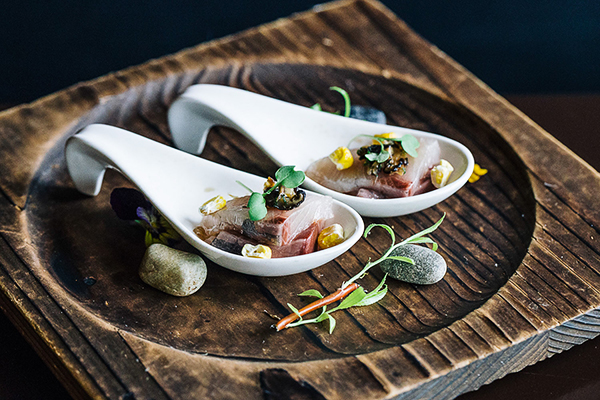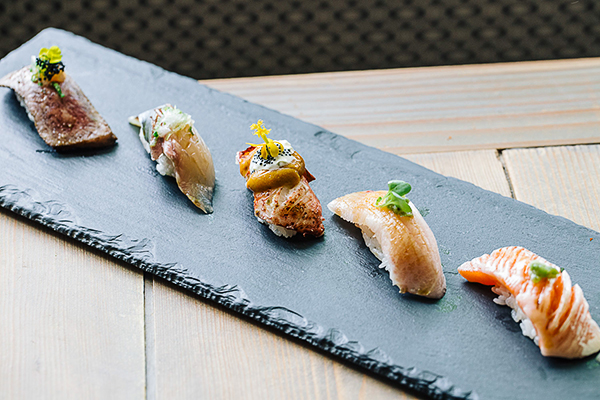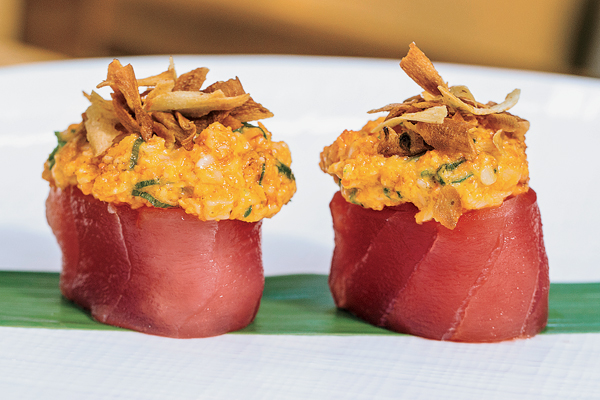Not so long ago, Chicago’s most popular sushi restaurants trafficked in ludicrous rolls with 28 ingredients doused in rum and set on fire—the kind of excess that would make a traditional sushi chef commit hara-kiri with a dull yanagi knife. Thankfully, those days are on the wane. Instead of tricking folks with flashy ingredients and showmanship, a new vanguard of chefs are employing subtle shades of flavor to enhance the fish itself, which, after all, is what sushi is all about. The standard-bearers of this mature approach? Arami, Juno, and Kai Zan. All are well established but have recently upped their game. In a town with approximately 200 sushi restaurants, these three are the best. But which of these medalists deserves the gold?
Juno has endured a lot in its four years. The Lincoln Park restaurant survived then-partner Jason Chan’s cancer scare, a fire, a renovation, and Chan’s transfer of ownership to his partner, sushi chef B.K. Park. It emerged even better. The room, which once seemed bleak, now feels welcoming. It teems with families and trendies alike; on a recent visit, a quick look down the 15-seat sushi bar lit with pendants revealed two couples on dates, one area chef, and a solo Japanese businessman. All good signs.
The promise that Juno had always hinted at is now a reality. Park’s serious team crafts elegant dishes, but the kitchen also pushes boundaries. Juno is best known, and justifiably so, for its signature smoked hamachi, which is served beneath a smoke-filled glass dome: The scent of smoldering cherrywood infiltrates the gleaming yellowtail and its accompaniments—shiitakes and sweet corn—and the nostrils of every diner in the room.

I was even more impressed by the Juno King nigiri, which employs maguro (tuna) as a makeshift wrapper that’s stuffed with heated spicy king crab chunks and topped with crunchy potato shavings. “Eat it quick, while it’s warm,” said my animated waiter. The slightest pressure from my tongue melted the tuna and chain-reactioned a pleasurable crab-salad implosion in my mouth.
It’s Juno’s quieter plates that really prove the chefs’ mastery. Hand rolls such as briny uni shiso (sea urchin with shiso leaf) and a tingly tako (octopus) get served like ice cream cones in a custom wood holder. Both showcase superior nori that crackles (the Japanese call the sensation pari-pari) and dissolves on the tongue. And the eight-piece Sake Yaki maki teams both raw and barely seared salmon with almond slices, a vinegary apple sliver, garlic chives, and lemon aïoli. The roll is bolstered by subtly sweet rice that makes the stuff elsewhere seem wan.
The rice and nori at Kai Zan can’t compare to Juno’s, but the beloved Humboldt Park joint makes up for that shortcoming in creative ways. Melvin and Carlo Vizconde’s tiny restaurant can barely contain its own energy and that of its adoring customers, nor does it have much use for niceties such as pacing or even good chopsticks. The sushi comes when it’s ready, and you eat it fast, usually with your fingers.
The overall vibe is catch-as-catch-can—I saw one chef cooking on a grill barely bigger than a Murakami paperback—but the compositions that emerge from behind the counter are sparkling. For example: four “pearls” of delicate escolar topped with crunchy scallions that have been soaked in soy sauce and truffle oil. The fish and toppings get seared just long enough to tame the fish’s oily flavor and crisp the top while leaving the rippled flesh below silky.

Other presentations, such as the Angry Crab, buttery nubs of imitation and real crab wrapped in bigeye tuna and crowned with shards of tempura batter, recall the crunch-topped Juno King nigiri but evince a subtler hand. And the Orange Rush—lightly seared, salmon-wrapped, citrus-glazed scallops presented on a scallop shell—explodes with a tart-salty punch. Your orders may even arrive together on whimsical fused plates: an unexpected level of artsy, Alinea-esque detail.
Some of the less challenging offerings, such as the tuna and cucumber roll, seem a little messy with their squishy nori—especially in comparison with Juno’s tightly composed displays. But Kai Zan also takes greater chances than Juno and flies higher. Enclosing warm shrimp tempura, unagi, and crab in walls of sliced avocado seems like a risky gambit, but the Green Monster roll proves to be a feat of engineering. “The avocados have to be perfect,” my waiter told me. The delicate approach paid off.

Like Juno, Arami also survived a recent kitchen fire and came back blazing. The menu at Ty Fujimura’s West Town spot covers tons of ground—skewers, ramen, small plates. The sun pouring through the skylight over the brick and wood dining room illuminates everything from octopus spring rolls to grilled chicken meatballs.
But chefs Ajay Popli and Nelson Vinansaca do their best work with raw fish. The hamachi carpaccio—seven yellowtail slabs fanned out like flower petals, each crowned with a jalapeño slice and chives—is tender enough to pierce with a chopstick. A hit of ponzu sinks into the fish and elevates every bite. For the Zuke Sake Hotate, the chefs wrap a chili-tinged Hokkaido scallop in torch-seared salmon and sprinkle it with sweet potato confetti. The temperature manipulation blisters the fish’s fat and infuses the flesh with smoky flavor.
Similar experimentation emboldens the ebi tempura asparagus maki roll, with its cap of lightly grilled spicy salmon and shreds of scorched ao nori (green seaweed). Once you get to the crunchy shrimp tempura, asparagus, and spicy mayo underneath, your tongue surrenders to the textural twist. And the wealth of vegetarian options—such as charred nasu (eggplant) nigiri with a subtle peanut and red miso dressing—are way preferable to the usual lip service paid to non–fish eaters in the form of spongy eggs and bland daikon.
In my own personal Sushi Olympics, Arami finishes a step below Juno and Kai Zan. Small demerits like gummy rice, salmon roe that flaccidly fizzle on the tongue, and a reliance on chili oil keep Arami from attaining glory. But these are the kinds of nitpicky flaws you notice only in the most rarefied air.
In the end, the gold goes to Kai Zan, whose exciting unpredictability trumps Juno’s steady reliability. The Vizconde brothers have created an idiosyncratic experience that can’t be replicated anywhere else in the city. Now that Chicago’s embarrassing sushi excesses have been largely consigned to the trash heap of history, we can celebrate 2017’s more nuanced approach, closer to what the sushi gods have always intended. Kai Zan is where I’ll do my rejoicing.


